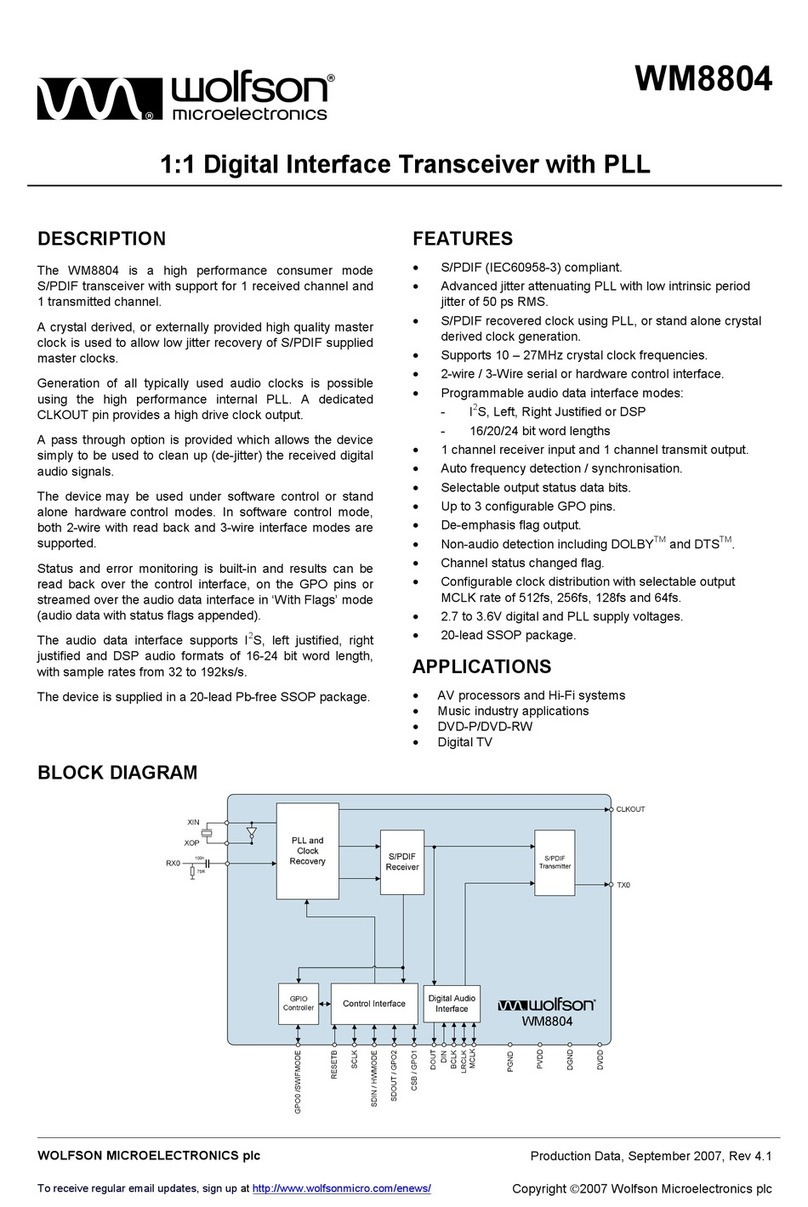wWM8580
Multichannel CODEC with S/PDIF Transceiver
WOLFSON MICROELECTRONICS plc
To receive regular email updates, sign up at http://www.wolfsonmicro.com/enews/
Production Data, March 2009, Rev 4.7
Copyright ©2009 Wolfson Microelectronics plc
DESCRIPTION
The WM8580 is a multi-channel audio CODEC with S/PDIF
transceiver. The WM8580 is ideal for DVD and surround
sound processing applications for home hi-fi, automotive
and other audiovisual equipment.
Integrated into the device is a stereo 24-bit multi-bit sigma
delta ADC with support for digital audio output word lengths
from 16-bit to 32-bit, and sampling rates from 8kHz to
192kHz.
Also included are three stereo 24-bit multi-bit sigma delta
DACs, each with a dedicated oversampling digital
interpolation filter. Digital audio input word lengths from 16-
bits to 32-bits and sampling rates from 8kHz to 192kHz are
supported. Each DAC channel has independent digital
volume and mute control.
Two independent audio data interfaces support I2S, Left
Justified, Right Justified and DSP digital audio formats.
Each audio interface can operate in either Master Mode or
Slave Mode.
The S/PDIF transceiver is IEC-60958-3 compatible and
supports frame rates from 32k/s to 96k/s. It has four
multiplexed inputs and one output. Status and error
monitoring is built-in and results can reported over the serial
interface or via GPO pins. S/PDIF Channel Block
configuration is also supported.
The device has two PLLs that can be configured
independently to generate two system clocks for internal or
external use.
Device control and setup is via a 2-wire or 3-wire (SPI
compatible) serial interface. The serial interface provides
access to all features including channel selection, volume
controls, mutes, de-emphasis, S/PDIF control/status, and
power management facilities. Alternatively, the device has a
Hardware Control Mode where device features can be
enabled/disabled using selected pins.
The device is available in a 48-lead TQFP package.
FEATURES
•Multi-channel CODEC with 3 Stereo DACs and 1 Stereo
ADC
•Integrated S/PDIF / IEC-60958-3 transceiver
•Audio Performance
−103dB SNR (‘A’ weighted @ 48kHz) DAC
−-90dB THD (48kHz) DAC
−100dB SNR (‘A’ weighted @ 48kHz) ADC
−-87dB THD (48kHz) ADC
•DAC Sampling Frequency: 8kHz – 192kHz
•ADC Sampling Frequency: 8kHz – 192kHz
•Independent ADC and DAC Sample Rates
•2 and 3-Wire Serial Control Interface with readback, or
Hardware Control Interface
•GPO pins allow visibility of user selected status flags
•Programmable Audio Data Interface Modes
−I
2S, Left, Right Justified or DSP
−16/20/24/32 bit Word Lengths
•Three Independent Stereo DAC Outputs with Digital
Volume Controls
•Two Independent Master or Slave Audio Data Interfaces
•Flexible Digital Interface Routing with Clock Selection
Control
•2.7V to 5.5V Analogue, 2.7V to 3.6V Digital Supply
Operation
•48-lead TQFP Package
APPLICATIONS
•Digital TV
•DVD Players and Receivers
•Surround Sound AV Processors and Hi-Fi systems
•Automotive Audio




























